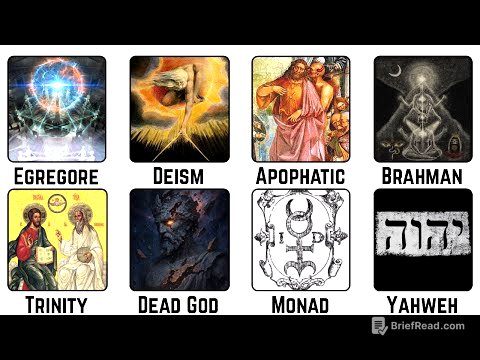TLDR;
This video explains why people often struggle with memory and introduces a powerful technique called visualization and association to improve recall. It emphasizes that memory isn't about rote repetition but about creating meaningful connections through vivid mental images and emotional associations. The video provides a step-by-step method to remember names, details, and information from books, and encourages viewers to apply these techniques in their daily lives to enhance confidence, connection, and control.
- Memory fails due to information overload and reliance on ineffective repetition.
- Visualization and association are powerful techniques to boost memory.
- Memory thrives on vivid, emotional, and meaningful connections.
- A four-step method is introduced: pay attention, create mental pictures, review briefly, and apply everywhere.
The truth about your memory [0:00]
Many people experience memory failures such as forgetting names, details in meetings, or the content of what they read. These failures can lead to frustration and a lack of confidence, causing individuals to believe they have a poor memory. However, the truth is that memory is not inherently broken but simply untrained. Research indicates that a simple change in how information is encoded can improve recall by as much as 76%. The video aims to explain why memory fails and provide a practical method to remember names, details, and books effectively.
Why you forget names, details, and what you read [1:18]
The modern age is characterized by information overload, with constant emails, texts, meetings, and notifications flooding the brain. Many people rely on repetition, one of the weakest forms of memory, such as repeating names or rereading sentences, hoping the information will stick. However, repetition without a strategic approach is not very effective.
Why repetition doesn’t work and how school taught us wrong [1:45]
The traditional education system, designed during the industrial age, focused on creating workers rather than innovators. This system emphasized rote memorization, where students repeat, test, and forget information, such as memorizing formulas for exams without practical application. The brain thrives on meaning, vividness, emotion, and connections to existing knowledge. This explains why people can remember song lyrics from their teenage years but struggle to recall what they read the previous night. A poor memory has significant costs, including lost opportunities, reduced credibility, and wasted time rereading material. Sharpening memory improves various aspects of life, enhancing confidence, preparedness, and trustworthiness at work. It also deepens relationships by recalling personal details and saves time by retaining learned information.
How visualization and association work [3:40]
Visualization and association is a simple memory technique. Instead of passively trying to remember by repeating words, connect the information to a vivid mental picture. For example, when meeting someone named Baker, imagine them wearing an oversized chef's hat and holding loaves of bread. For someone named Rose, picture a bouquet of red roses growing out of her hair. The sillier and more exaggerated the image, the better, as the brain loves the unusual. This technique also works for academic terms; instead of glazing over the word "hippocampus," picture a giant hippo stomping across a campus with a backpack full of books.
Study from Memory and Cognition [5:49]
The brain is designed to remember images, locations, and stories, with up to 80% of information processed visually. Translating data into pictures caters to the brain's natural preference, making it easier to retain. A study in the journal "Memory and Cognition" found that people who paired words with visual imagery remembered 76% more than those who used repetition. Dual coding, using both verbal and visual information, activates multiple brain areas, creating stronger memory traces.
How your brain encodes information visually and emotionally [6:34]
Encoding information in multiple ways, such as with images, emotions, and associations, builds multiple pathways to that memory, making it stronger and faster to retrieve. This is why skills like riding a bike or memories of childhood homes are unforgettable, as they are full experiences packed with images, emotions, and repetition across different contexts. Similarly, songs pair words with rhythm, melody, and emotion, activating more brain areas and creating multiple threads in the same memory. Visualization and association work by turning plain information into something rich that the brain feels compelled to remember.
Step 1 – The foundation of memory [10:11]
The first step to improve memory is to pay attention. Every memory starts with focus, and you can't remember what you never fully noticed. Forgetting someone's name often happens because you weren't really listening when they said it, perhaps distracted by other thoughts or your phone. The first rule of memory is to be present. When meeting someone, pause, look them in the eye, and repeat their name back to them, giving your brain the raw material it needs to encode the information later.
Step 2 – Create vivid mental pictures (examples with names) [10:57]
Once you have the name or information, translate it into an image. The stranger, sillier, or more exaggerated, the better. For example, if the person's name is Lily, imagine a giant lily flower sprouting off the top of her head. For Mark, picture him walking around with giant markers stuffed in every pocket, leaving streaks of ink everywhere. The brain is more likely to remember the unusual than the usual, the extraordinary versus the ordinary.
Step 3 – Quick review: the 60-second daily recall [12:00]
Review briefly. This step takes less than a minute but multiplies your results. Later in the day, run through the people you met and the images you created. Just a quick mental review. For example, Lily was the woman with the giant flower in her hair, and Mark was the guy dripping ink from his markers. This quick recall is like pressing save on your brain's hard drive. Neuroscience shows that recalling something, even briefly, strengthens the neural pathway, making it easier to retrieve in the future.
Step 4 – Apply it everywhere: studying, languages, to-do lists [12:45]
Apply this technique everywhere. Once you practice with names, you'll realize it works for almost everything. When studying for an exam, turn each term into a picture and link it. When learning a new language, turn foreign words into vivid images. When preparing for a speech, turn your talking points into a sequence or story of mental pictures you can walk through. Even simple tasks like remembering a grocery list become easier by imagining a cow standing inside your refrigerator, handing you milk and eggs balancing on its horns, and a loaf of bread flying out of your toaster like a rocket.
7-day memory challenge [13:51]
For the next seven days, pick three new things every day to practice with: one name from a person you meet, one concept from something you're learning, and one everyday item from your to-do list. Turn each of those into a vivid image and link it to something familiar. At the end of each day, spend just one minute reviewing those images. By the end of the week, you'll notice recalling details feels much easier, you'll remember names you used to forget instantly, and you'll remember more of the concepts you studied days earlier. Most importantly, you'll feel less stressed and more confident in your memory.









